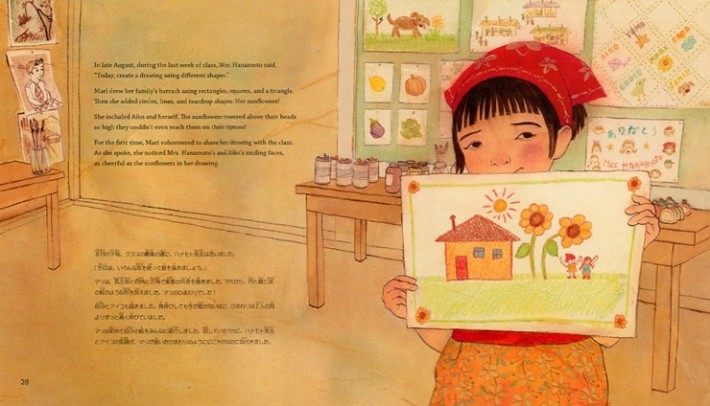It can be hard to find hope when things are bad. But the moving children’s book “A Place Where Sunflowers Grow” shows that beauty can still grow in the worst situations. This strong story shows how we can get through hard times with courage, creativity, and connection with others.
The History Behind the Book
“A Place Where Sunflowers Grow” tells the tale of a young Japanese American girl named Mari, whose family was forced into an internment camp during World War II. This fictional story was inspired by author Amy Lee-Tai’s own family history. Her grandparents helped establish an art school in the Topaz internment camp, where they taught Mari’s real-life counterpart – Lee-Tai’s mother.
Lee-Tai wanted to share her family’s experience through the eyes of a child. She worked with illustrator Felicia Hoshino, who also had a personal connection to this history through her own family. Together, they created a story that conveys both the injustice of the internment camps and the resilience of those trapped within them.
Finding Beauty in Bleak Surroundings
At the start of the book Mari feels hopeless. After being forced to leave their home in California, she and her family now live in a desert barrack in Utah. She feels that everything has been taken from her.
When Mari attends her first art class, she struggles to come up with anything to draw. But with her teacher’s encouragement to depict something from her life before the camp, Mari illustrates her vibrant backyard garden. This uplifting memory from home brings a smile to her face.
Creating this art helps Mari find beauty in bleak surroundings. She starts putting up bright drawings in her family’s barrack that make them all remember better times. Through her creative spirit, she finds purpose.
Cultivating Connections Amid Hardship
As Mari continues to take art classes, she starts to become friends with a classmate named Aiko. Mari looks forward to the walk home from school when she has a friend with her, which takes her mind off of how hard things are at camp.
Aiko gives Mari the courage to open up and ask questions about their situation that she’d been afraid to voice before. Their bond blossoms through sharing stories and ideas During a time of disconnection, they cultivate human connection.
Finding Hope Through Perseverance
Earlier in the story, Mari had planted sunflower seeds with her mother but doubted anything could grow in the desert sand. After months of patiently watering the seeds, she is filled with hope at the sight of tiny sprouts peeking through – a sign of the beauty that can emerge through dedication, even in the harshest climates.
The book’s message is that there are always things to live for, if we open our eyes to them. Friendship, family, nature, art – these can sustain us through all seasons, leading us from the bleakness of winter to the blossoms of spring. If we nurture our spirits, inner light will shine through.
Why This Book Matters
“A Place Where Sunflowers Grow” provides an accessible way for children to learn about the injustice of Japanese American internment. It opens young readers’ eyes to this difficult history through a relatable child’s perspective.
But more than just informing, at its heart this book is about inspiration. In its pages, we see how Mari finds light through creativity, human connection, and perseverance. We’re reminded that even in life’s darkest chapters, there is still beauty to be found if we have hope. This timeless message can speak to all of us, no matter our age or circumstances.
By honoring the past while offering an uplifting vision for the future, “A Place Where Sunflowers Grow” shares a story that can cultivate hope in readers of all ages. Its lessons on finding beauty in brokenness ring true in every time, place, and season.

How to harvest sunflower seeds

After flowering, sunflower heads develop masses of seed. You can pick these to use in cooking, but before you eat them, you’ll need to peel off the tough seed coat. Even better, take the seeds off the seedhead and let them dry for a few days. Then, put them in a paper envelope and put it somewhere dry so you can plant them again the next year. Make sure you leave some seeds for the birds, too.
How to plant sunflowers

If your garden has a lot of slugs and snails, your sunflowers may benefit from being potted on into larger pots of fresh compost, then hardened off before planting out into the soil. This means the plants will be bigger when in their final growing positions, and therefore more resilient to slugs and snails. Regardless of how big they are, dont plant seedlings out until the soil has warmed considerably and the risk of frost has passed.
In this clip from Gardeners World, you can see Monty Don plant sunflower seeds as part of his bigger sunflower test:
When planting out, prepare the soil by removing weeds and if necessary add plenty of organic matter such as compost or well-rotted manure. Plant the sunflowers at the same depth they were in the pot. Water well and stake taller varieties with a bamboo cane or similar.
Here, Monty plants out his sunflowers and explains how to stake them:
